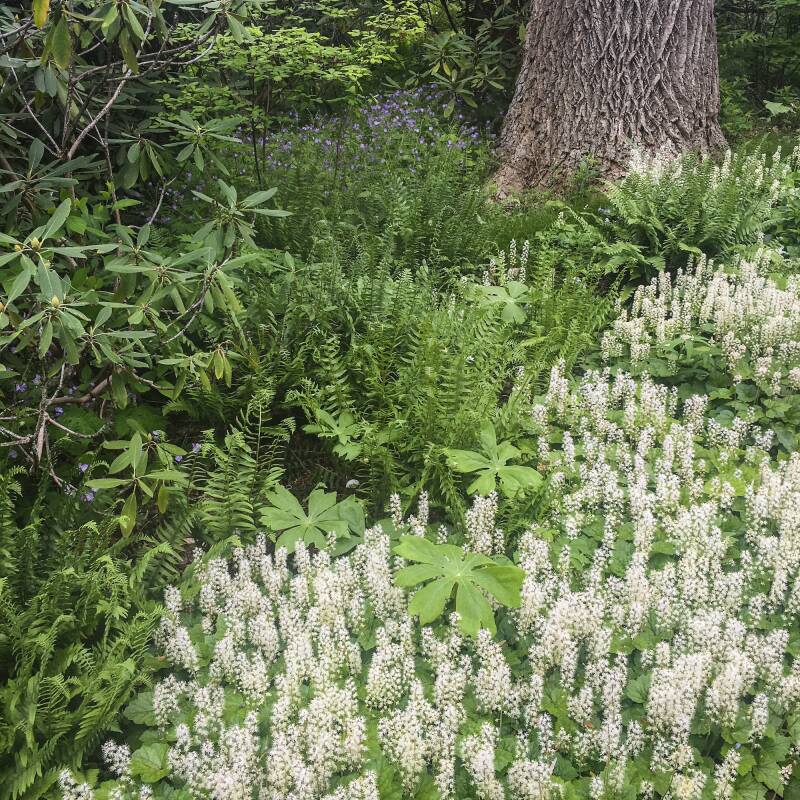This is part of a series with Perfect Earth Project, a nonprofit dedicated to toxic-free, nature-based gardening, on how you can be more sustainable in your landscapes at home.
With all the recent storms and severe weather happening across the country, many of us are besieged with debris from trees and shrubs. Instead of hauling it to the landfill, where it will just add to methane pollution, make something beautiful and beneficial out of it. In fact, keeping garden debris, or biomass (organic matter like branches, stems, and leaves), on your property is one of the principles of nature-based gardening we introduced in last month’s column with Perfect Earth Project. Brush piles offer protection to birds, like wrens, thrushes, and warblers, and other wildlife, like amphibians, reptiles, and small mammals. Leaf litter becomes homes for insects. And when biomass decomposes, it feeds your soil—for free!
There are artful ways to display biomass in your garden. Perfect Earth Project founder Edwina von Gal constructs striking sculptures out of debris gathered from her yard on Eastern Long Island. She’s woven branches through tree trunks, built walls out of logs, and knitted sticks together to create large nests. “Tailor the style of your habitat pile to the style of your garden,” she says. If your garden is tightly managed, create something more deliberate, recommends von Gal. On the other hand, if you have a meadow or loosely planted beds, like von Gal has in her garden, you can be freer in your construction.
At Chanticleer garden in Wayne, PA, assistant horticulturist Chris Fehlhaber constructs a habitat pile each year after the meadow is cut back in early spring. (He waits as long as possible to cut back the meadow with a scythe to allow for overwintering insects to emerge.) To craft the stack, Fehlhaber drives a wood stake in the ground and builds around it so that it’s sturdy and strong. “I start by creating a level base and then work around the pole in either a clockwise or counter-clockwise rotation to ensure there is plenty of overlap for strength, stability, and balance,” he says. He continues the process until all the material is used. “Then, I gather woody debris from the previous year and ‘top’ the stack with it, arranging the branches on top to create a well-balanced dome, which helps weigh the top down and sit it neatly around the pole.”
“Songbirds, insects, toads, and snakes have all been observed utilizing the stacks for shelter,” says Fehlhaber. He’s spied goldfinches using them to feed on seedheads in the meadow during fall and winter and to hide from predators, like red-tailed hawks. “The coarse nature of the stacks means there are many niches for birds and wildlife,” he says.
Channel your inner Andy Goldsworthy or Maren Hassinger (see her inspiring exhibit at LongHouse Reserve, made from branches gathered on the property), and create art from nature. “Think of every fallen branch you find or invasive shrub you cut down, as a new opportunity,” says von Gal. “Be creative and have fun.”
Below, some examples of how Von Gal and Fehlhaber transform yard waste into artful critter shelter.
Photography by Melissa Ozawa.







See also:
- ‘Stop Putting Your Garden into Shapewear’: 12 Tips for Nature-Based Gardening
- Backyard Composters, Explained: The Good, the Hot, and the Wormy
- Ask the Expert: Conservationist Matthew Shepherd on Protecting Beneficial Insects












Have a Question or Comment About This Post?
Join the conversation (1)